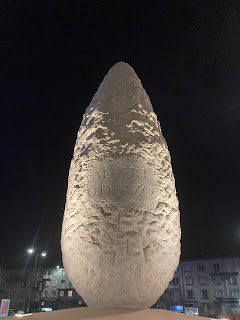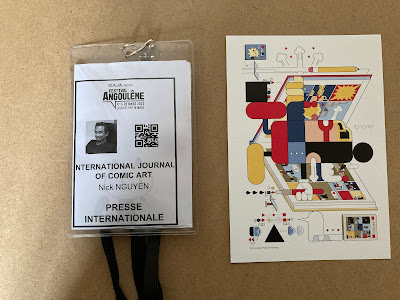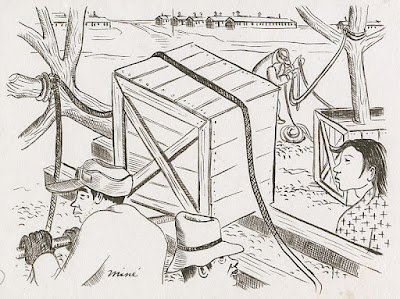Danny Fingeroth and Roy Thomas (eds.). The Stan Lee Universe. Raleigh: TwoMorrows Publishing, 2011. 175 pp. ISBN: 978-1605490298. US $8.99. https://twomorrows.com/index.php?main_page=product_info&cPath=123_140&products_id=934 (only digital version still available)
Reviewed by Michael Kobre
A common image of Stan Lee for hundreds of millions of fans all over the world who've seen an Avengers or Spider-Man movie or who've read a few Marvel comics, is that of an avuncular genius who created a whole new pantheon of myth—"this generation's Homer," according to a Princeton student in 1966. Another image, distilled from the remembrances of some of his collaborators and from the comic book industry's long history of exploiting its creators, has shadowed Lee as well. In this version of the story, he's a carnival huckster shilling lies and stolen goods, claiming credit for work that isn't his, while reaping the wealth and fame that should have gone to the artists who really created Marvel Comics. This version of Stan Lee, in fact, looks a lot like Funky Flashman, a devious and numbingly loquacious promoter decked out with a toupee and a fake beard—a caricature of Lee, that is—who tormented Jack Kirby's Mister Miracle, one of the heroes Kirby created for DC. Kirby, whose art defined Marvel at least as much as Lee's words, had quit working for Marvel in 1970, fed up at last with all the broken promises of more generous financial rewards and creative credits for his work. And it's this version of Stan Lee as well who's the protagonist of Abraham Riesman's 2021 biography of Lee, True Believer: The Rise and Fall of Stan Lee. Carefully researched and gracefully written, Riesman's biography nevertheless insistently views Lee through the darkest possible prism. For Riesman, Lee is, above all, a con man and liar. As Riesman writes in his book's prologue, "[Lee] lied about little things, he lied about big things, he lied about strange things, and there's one massive, very consequential thing he may very well have lied about. If he did lie about that last thing—and there's substantial reason to believe he did—it completely changes his legacy" (12).
At the core of this divide over Lee's character and work is, of course, that other long-running argument about the respective contributions of Lee, Kirby, Spider-Man artist Steve Ditko, and others to the creation of Marvel's characters and worlds. Lee's "Marvel Method" of creating comic books, in which artists like Kirby and Ditko would work from loose plot descriptions generated in increasingly-rushed conversations (which may or may not have ever been written down) meant that Marvel's artists had unprecedented freedom to shape and pace the stories they told, in a form of creation that Charles Hatfield has called "narrative drawing" (Hatfield 15). But the free-wheeling, improvisational nature of the Marvel Method also meant that Lee's own contributions were unclear, in spite of the line in so many credit boxes in so many Marvel comics that claimed that they were "Written by Stan Lee" (or "Smiling Stan" or "Stan the Man" or any of the other affectionate sobriquets that Lee employed in credit boxes). Yes, Lee added the dialogue and captions after the artists submitted their pages, but what role had he really played in conceiving the characters and plots? By 1989, Kirby said flatly that Lee's role hadn't been much at all. "I've never seen Stan Lee write anything," Kirby told Gary Groth for a Comics Journal interview. "I used to write the stories just like I always did" (Groth 37). In True Believer, Reisman even questions Lee's role in creating Fantastic Four #1 in 1961, the book that launched the Marvel era. "…[O]utside Stan's own oft-repeated words," Reisman writes, "there is currently no known evidence that he created the premise, plot, or characters that appeared in Fantastic Four #1. No presentation boards, no contemporary legal documents, no correspondence, no diary entries. Nothing" (105).
In light of all the questions raised again by Riesman's biography and as part of the inevitable ongoing revaluation after Lee's death in 2018, it's helpful to look back at a 2011 collection of Stan Lee interviews, tributes, critical examinations, and miscellanea from Lee's archives, The Stan Lee Universe. Edited by Danny Fingeroth, whose own 2019 biography of Lee, A Marvelous Life: The Amazing Story of Stan Lee, offers a more conventional portrayal than Riesman's, and by long-time Marvel writer and editor Roy Thomas, who describes himself here as Lee's "left-hand man" in Marvel's glory days, The Stan Lee Universe is, not surprisingly, an unequivocally admiring portrait of Lee. Arranged more or less chronologically, the collection follows Lee's career from a 1957 profile which focuses on the short-lived comic strip about a group of cub scouts, Mrs. Lyons' Cubs, that Lee created with artist Joe Maneely (Lee, always hungry for recognition, notes with "very great satisfaction" in the profile that the strip "has been approved by the chief Scout executive") to at least brief references to some of his final projects, including his mostly forgettable reality shows Who Wants to be a Superhero? and Stan Lee's Superhumans. Along the way, we also see family photos; notes Lee exchanged with film directors, including Alain Resnais, James Cameron, and Oliver Stone; pages from an unpublished screenplay for Resnais; an advertisement featuring Lee for Hathaway shirts; stills from a 1976 razor blade commercial, also featuring Lee; pitches for unrealized Marvel projects from Will Eisner and Richard Corben; and even a note from Lee to the president of United Airlines praising a stewardess who helped Lee and his wife Joan when she became ill during a flight. Among other odd discoveries in this material is Lee's suggestion to Resnais that he direct a Spider-Man movie starring Henry Winkler.
But the heart of the book—as the center of Lee's story always will be—concerns his years as Marvel's most prominent scripter and its editor-in-chief. And it's on this subject that the interviews, analyses, and testimonials in the book do, in fact, help us understand a little more clearly the significance of Lee's contributions to the creation and rise of Marvel Comics. The Stan Lee Universe accomplishes this though, whether intentionally or not, by shifting the terms in which we might consider those contributions. Although there's a fine analysis by Peter Sanderson late in the book of Lee's style in dialogue and captions—Sanderson is particularly good at discussing Lee's use of the words "naught" and "smoldering" in a Thor caption—Lee in the interviews and the other artists and writers in their various testimonials don't actually have much to say about his work as a writer. There are general comments about the importance of characterization and vivid dialogue, but there's no sustained conversation about any individual story. Instead, what the book illuminates is Lee's work as an editor, shaping some of Marvel's signature characteristics (including ones essential to its wildly successful screen adaptations) and, of course, defining its brand.
In remembrances of Lee, for instance, by writers like Thomas, Denny O'Neill, and Gary Friedrich and by such artists as Gene Colan, John Romita, and Herb Trimpe, Lee is consistently portrayed as an exacting editor with a clear vision of what he wanted on Marvel's covers, in its plots, in its art—Trimpe remembers Lee tossing pages of layouts into a trash can because Trimpe had used too many small panels—and even in the placement of dialogue and captions. For the writers, in particular, Lee was a teacher also. "He'd call us in and have us stand by him in front of the drawing table and go over the completed artwork of a story we'd written or one he'd written," Friedrich recalls, "and he'd edit it with us standing there, explaining any changes he'd made, why he put a balloon in a certain place, why he had a character say this rather than that, etc. One thing in particular I remember that he continually drove home was to always move the story forward. 'Every word that's spoken should be for the purpose of moving the story along,' he'd tell us again and again" (54). Even in later years, when Lee would receive almost finished pages, Thomas remembers, "the fact that Stan hadn't seen the dialogue and captions before they were rendered in ink in no way inhibited him from making changes … substantial changes" (50).
Lee was, of course, also a master at developing Marvel's brand. "Thinking back," he says in a 1974 interview, "the whole thing was treated like an advertising campaign. The catch phrases, like 'Make Mine Marvel' and 'Face Front' and 'Excelsior' …I did it unconsciously, but it was all in the direction as though … I was building a product. I wanted to make Marvel Comics a product that people … would love" (124). In a detailed analysis of how Lee shaped Marvel's letter pages and then conceived and wrote the Bullpen Bulletins Page, which in 1967 began including "Stan's Soapbox," David Kasakove writes that "Stan Lee's editorial voice—at once frantic, comic, self-deprecating, tongue-in-cheek, good-natured, wildly self-congratulatory and (sometimes) moralistic—was a years-long tour de force, the glue that held the Marvel Age of Comics together" (130).
Reading The Stan Lee Universe also reminds us of how Lee's editorial vision helped shape Marvel's signature characteristics in the 1960s, innovations that would effectively redefine the conventions of virtually all superhero narratives in comics and later in other media. Looking back in a 1974 interview, in the context of retelling his familiar story about creating the Fantastic Four (and, as usual, taking credit for the characters' conceptions), Lee singles out his insistence on a kind of realism. "I tried to do everything I could to take these super-powered characters and in some way to make them realistic and human," he says. "To have them react the way normal men might react if these normal men happened to have superhero powers" (124). But while the respective contributions of Lee, Kirby, and Ditko to the creations of the Fantastic Four and Spider-Man will always be—at least to some extent—uncertain, the kind of realism Lee describes, particularly in Marvel's early years when he was practically the company's only writer, seems to have more of his imprint. We hear Lee's voice, I'd argue, in scenes like Spider-Man's failed attempt to cash a check in his name in Amazing Spider-Man #1 or a scene in Fantastic Four #9 that Lee recalls in that 1974 interview when "They're evicted from their headquarters because they can't pay the rent because Reed Richards invests all their reward money in stocks and the markets take a nosedive" (124). For all of the qualities of Marvel Comics that flow into the solo work of Kirby and Ditko after they left Marvel, there are no moments like these: poignant, comic scenes, anchored in mundane realities and steeped in a kind of wry melancholy that turns superheroes into Yiddish shlemiels.
Moments like these, however, would become less prominent as Lee became more involved in promoting Marvel Comics than in writing them and as Marvel's universe expanded too. But that concept of a shared universe, which was as much about branding and marketing as it was about storytelling, was clearly Lee's innovation. As he says in a 1968 interview, "… what we try to do, and I think we were probably the first at this, we try, even though they're different characters in different magazines, and possibly even living in different places, we try to make it all like one little world in which these characters exist, the Marvel world …" (44). Even Reisman concedes that Lee deserves credit for Marvel's shared universe: "Kirby never took credit for that idea—indeed, his assistant and biographer, Mark Evanier, says Kirby found it cumbersome and irritating, because it forced him to incorporate other people's ideas into his own comics. But Stan was enormously proud of the notion of the Marvel Universe and maintained it in all the superhero books" (129). Over time too, in light of Marvel's success, all superheroes existed in shared universes like this, and it's no exaggeration to say that the translation of this concept to the Marvel cinematic universe is a vital component of Marvel Studios' success on-screen, a narrative convention that's since been adapted, for good or ill, in so much other franchise storytelling in movies and other media forms.
So what about that other question then? Who really created Marvel's characters and the universe-spanning epics they inhabit? Lee in the interviews here mostly tells the familiar story that he created the Fantastic Four and so many other characters. As the years pass in the book, we see him growing into the persona that would consume him for the rest of his life, as, for instance, in a 1974 interview, when he considers at length how he's absorbed Shakespeare's influence. But Lee is also careful to acknowledge how Marvel's artists, especially Kirby, co-created its stories. "… [T]he artist is part writer—" he says in a 1969 interview, "—he's breaking the story down as he sees it …" (78). In the earliest interview in the book, from 1965, Lee is remarkably open about Kirby's role in creating stories:
Some artists, of course, need a more detailed plot than others. Some artists, such as Jack Kirby, need no plot at all. I mean, I'll just say to Jack, "Let's let the next villain be Doctor Doom" … or I may not even say that. He may tell me. And then he goes home and does it. He's so good at plots, I'm sure he's a thousand times better than I. He just about makes up the plots for these stories. All I do is a little editing… I may tell him he's gone too far in one direction or another. Of course, I'll occasionally give him a plot, but we're practically both the writers on the things. (11)
The documentary evidence in The Stan Lee Universe, however, doesn't settle anything. The book reprints a plot synopsis for Fantastic Four #1, which Reisman describes as "a curious document with a questionable history" that may have been written years after the comic's publication (106). Indeed, Roy Thomas' notes about the document here do little to clarify its provenance, as Thomas tells us how he was summoned into Lee's office one day late in the '60s so that Lee could show him the synopsis which Lee claimed to have found in a filing cabinet the night before—although Thomas does note that the synopsis looks like other typed plot summaries from the early '60s that Lee had previously shown him, including one for Fantastic Four #8 that's also included in The Stan Lee Universe. If anything though, other documents in the book don't make much of a case for Lee as a writer. Reproductions of pages from occasional prose stories he wrote for Marvel publisher Martin Goodman's other magazines and from Lee's unproduced screenplay for Resnais are all pretty routine stuff, mired in genre conventions or heavy-handed stereotypical characterizations. For that matter, the reproduction of materials from Lee and Kirby's last collaboration, a 1974 Silver Surfer graphic novel published by Simon and Schuster, strongly suggest that the book's story was mostly Kirby's, as he carefully details the plot in lengthy typed letters accompanying his artwork which are addressed to "Stanley" (and signed "Your pal, Jack") (153-155).
Ultimately, the exact details of Lee's collaborations will never really be known. As Thomas notes in his comments on the Fantastic Four #1 synopsis, by 1965 Lee "was increasingly dispensing with written synopses, with Marvel artists often working merely from brief conversations, in person or over the phone" (15). Instead of written documents, we have Gene Colan's memory of recording phone calls with Lee or John Romita, Jr.'s memories of his father's anxiety after driving away from a plot session with Lee. "Oh, God, I didn't write any of this down," Romita, Jr. recalls his father saying, "how am I gonna remember all of this stuff?" (108). But if we must continue to dwell in uncertainty about what exactly transpired in Lee's work with Kirby, Ditko, and so many others, The Stan Lee Universe is an informative and entertaining field guide to that territory. Copiously illustrated, it brings to life again Lee's crowning moment as he helped to usher in the Marvel Age of Comics. If, as Reisman asserts, Lee's impulse to exaggerate his claims as a creator while failing to properly recognize his own achievements as Marvel's editor "was a core tragedy of Stan's existence and legacy," The Stan Lee Universe helps us at least to see those achievements more clearly (67).
References
Fingeroth, Danny, and Roy Thomas, editors. The Stan Lee Universe. TwoMorrows Publishing, 2011.
Fingeroth, Danny. A Marvelous Life: The Amazing Story of Stan Lee. St. Martin's Press, 2019.
Groth, Gary. "I've Never Done Anything Halfheartedly." The Comics Journal Library: Jack Kirby, Fantagraphic Books, 2002, pp. 18-49.
Hatfield, Charles. Hand of Fire: The Comics Art of Jack Kirby. University Press of Mississippi, 2012.
Riesman, Abraham. True Believer: The Rise and Fall of Stan Lee. Crown, 2021.
A version of this review will appear in print in IJOCA 23:2.



























